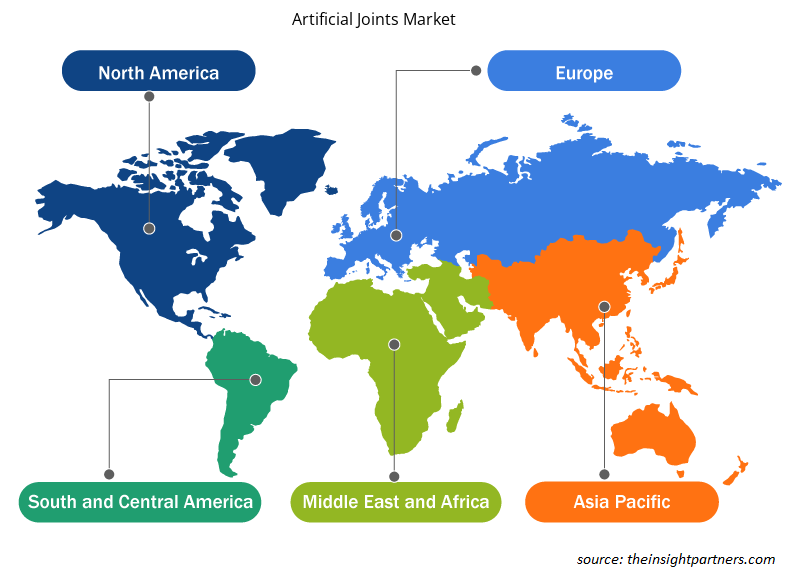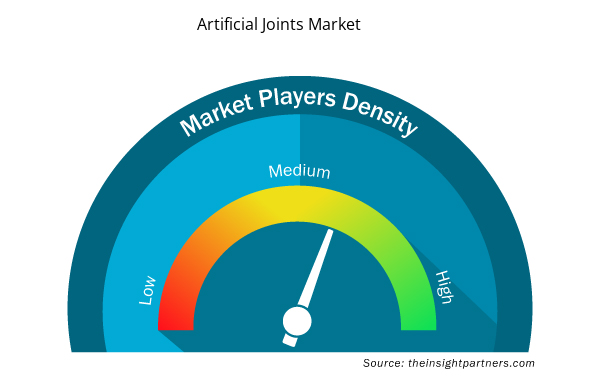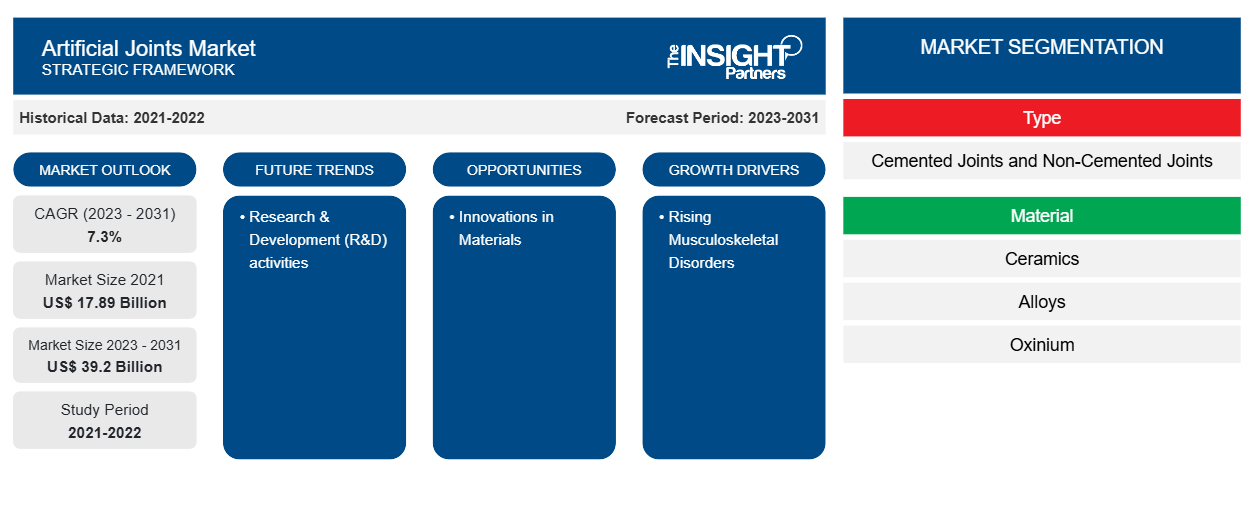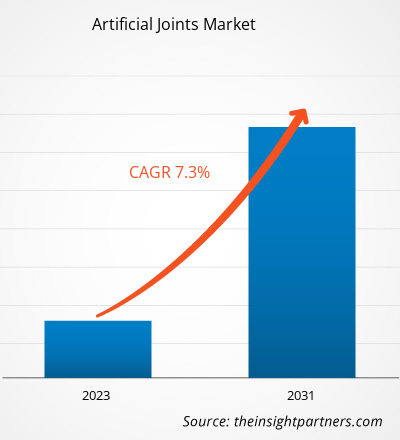Der Markt für künstliche Gelenke wurde 2021 auf 17,89 Milliarden US-Dollar geschätzt und soll bis 2031 39,2 Milliarden US-Dollar erreichen. Von 2023 bis 2031 wird für den Markt eine durchschnittliche jährliche Wachstumsrate von 7,3 % erwartet. Forschungs- und Entwicklungsaktivitäten (F&E) werden voraussichtlich weiterhin wichtige Trends auf dem Markt für künstliche Gelenke bleiben.JointsMarket was valued at US$ 17.89 billion in 2021 and is expected to reach US$ 39.2 billion by 2031. The market is expected to register a CAGR of 7.3% from 2023–2031. Research & Development (R&D) activities is likely to remain key Artificial Joints Market trends.
Künstliche GelenkeMarktanalyse
Zunahme von Muskel-Skelett-Erkrankungen
Gelenkersatz ist zu einem wesentlichen Faktor für die Erhaltung und Wiederherstellung geworden, um eine breite Palette von muskuloskelettalen Problemen bei muskuloskelettalen Erkrankungen zu behandeln. So wurden beispielsweise im Jahr 2019 in England mehr als 200.000 Hüft- und Kniegelenkersatzoperationen durchgeführt, davon 189 Hüft- und 130 Kniegelenkersatzoperationen. Daher steigt mit der Zunahme von muskuloskelettalen Erkrankungen die Nachfrage nach künstlichen Gelenken. Moderne künstliche Gelenke sind Hightech-Produkte, die aus speziellen Materialien unter Verwendung einzigartiger technologischer Geräte hergestellt werden. Diese Designs werden auf der Grundlage von Systemanalysemethoden, dem physiologischen Zustand der Patienten und der Beseitigung der Komplikationen gerechtfertigt und entwickelt. Daher sind die Entwicklung moderner künstlicher Gelenke mit nicht-invasiver Operationsoption, die für die Patienten weniger schmerzhaft sind, die einflussreichsten Faktoren, die für das Wachstum des Marktes für künstliche Gelenke in den Jahren 2021–2031 verantwortlich sind.
Künstliche GelenkeMarktübersicht
Technologie, Innovation und intelligente technologische Lösungen wie diese beeinflussen künstliche Gelenke weiterhin erheblich. Zunehmende Erkrankungen des Bewegungsapparats und intelligente Technologien bei künstlichen Gelenken sind die einflussreichsten Faktoren, die für das Wachstum des Marktes für künstliche Gelenke verantwortlich sind. Forschungs- und Entwicklungsaktivitäten (F&E) sind ein wichtiger Trend für das Wachstum des Marktes für künstliche Gelenke. Innovationen bei Materialien werden lukrative Marktchancen bieten.
Passen Sie diesen Bericht Ihren Anforderungen an
Sie erhalten kostenlos individuelle Anpassungen an jedem Bericht, einschließlich Teilen dieses Berichts oder einer Analyse auf Länderebene, eines Excel-Datenpakets sowie tolle Angebote und Rabatte für Start-ups und Universitäten.
- Holen Sie sich die wichtigsten Markttrends aus diesem Bericht.Dieses KOSTENLOSE Beispiel umfasst eine Datenanalyse von Markttrends bis hin zu Schätzungen und Prognosen.
Künstliche GelenkeMarkttreiber und Chancen
Intelligente Technologien für künstliche Gelenke begünstigen den Markt
Hersteller möchten intelligente orthopädische Implantate entwickeln, die den Krankheitsverlauf bei Patienten überwachen. Webster ist ein solcher Hersteller, der intelligente orthopädische Implantate entwickelt, die den Krankheitsverlauf bei Patienten überwachen und die Informationen dann per Funk und Handgerät an medizinisches Fachpersonal übermitteln. Bei einer Infektion könnten die Implantate nicht nur die Ärzte alarmieren, sondern auch ein Medikament freisetzen. Traditionell wird für künstliche Implantate robustes und leichtes Titan verwendet. Webster verwendet jedoch ein anderes Material als Titan mit einer oxidierten Oberfläche, die mit Kohlenstoffnanoröhren beschichtet ist, die als Elektrode fungieren. Durch Anlegen einer Spannung und Messen der Leitfähigkeit der Implantatoberfläche könnten Ärzte mithilfe der Nanoröhren eines der drei Dinge erkennen, die mit einem Implantat passieren können. Daher werden intelligente künstliche Gelenke in den kommenden Jahren einen beträchtlichen Markt erobern, und selbst Top-Hersteller wie Zimmer Biomet werden Geräte entwickeln, die die traditionellen Methoden der künstlichen Gelenkimplantate übertreffen werden.orthopaedic implants that monitor patients progression and then transmit the information to healthcare professionals through radio and a handheld device. If infection occurs, the implants could not only alert doctors, but also can release a drug. Traditionally, strong and lightweight titanium is a material choice for artificial implants. However, Webster is using a different material other than titanium with an oxidized surface that's coated with carbon nanotubes with working as an electrode. By applying a voltage and measuring the conductivity of the implant surface, doctors could use the nanotubes to sense one of the three things that can happen to an implant. Therefore, smart artificial joints will take a considerable market in the coming years and even top manufacturers like Zimmer Biomet will develop devices that will overcome traditional artificial joints implants methods.
Innovationen im Markt für Materialien für künstliche Gelenke – eine Chance
Dank Innovationen bei Operationstechniken sind Eingriffe wie Hüftgelenkersatz und Knieoperationen zur gängigen Praxis geworden. Darüber hinaus bieten Innovationen bei künstlichen Gelenkmaterialien den Herstellern auf lange Sicht lukrative Marktchancen. So kann beispielsweise die Entwicklung eines patentierten Nylontyps als zusätzliche Beschichtung auf der Kunststoffoberfläche eines Gelenkersatzes verwendet werden. Diese Oberfläche bedeckt den Kugelteil eines Kugelgelenks, der normalerweise aus einem „Ultrahochmolekulargewicht-Polyethylen (UHMWPE)“-Material besteht. Darüber hinaus werden derzeit noch Versuche durchgeführt, bei denen Nylonbeschichtungen mit UHMWPE kombiniert werden, um ein neues Material mit spannenden Eigenschaften zu schaffen. Daher bieten Materialinnovationen bei künstlichen Gelenken lukrative Marktchancen, die in den kommenden Jahren für beträchtliche Marktanteile sorgen werden.
Künstliche Gelenke
Marktbericht-Segmentierungsanalyse
Wichtige Segmente, die zur Ableitung der Marktanalyse für künstliche Gelenke beigetragen haben, sind Eignung und Dienstleistungen.
- Basierend auf dem Typ ist der Markt für künstliche Gelenke in zementierte und nicht zementierte Gelenke unterteilt. Die zementierten Gelenke könnten im Jahr 2023 einen größeren Marktanteil haben.
- Basierend auf dem Material ist der Markt für künstliche Gelenke in Keramik, Legierungen, Oxinium und andere unterteilt. Die Keramik könnte im Jahr 2023 einen größeren Marktanteil haben.
- Basierend auf der Anwendung ist der Markt für künstliche Gelenke in künstliche Kniegelenke, künstliche Hüftgelenke, künstliche Schultergelenke und andere unterteilt. Die künstlichen Kniegelenke könnten im Jahr 2023 einen größeren Marktanteil haben.
- Basierend auf dem Endverbraucher ist der Markt für künstliche Gelenke in Krankenhäuser, ambulante Pflegezentren und andere unterteilt. Die Krankenhäuser könnten im Jahr 2023 einen größeren Marktanteil halten.
Künstliche Gelenke Marktanteilsanalyse nach Geografie
Der geografische Umfang des Marktberichts für künstliche Gelenke ist hauptsächlich in fünf Regionen unterteilt: Nordamerika, Asien-Pazifik, Europa, Naher Osten und Afrika sowie Südamerika/Süd- und Mittelamerika.
Nordamerika dominiert den Markt für künstliche Gelenke. In Nordamerika haben die USA einen beträchtlichen Anteil an künstlichen Gelenken. Die Präsenz führender Medizinproduktehersteller in den USA und steigende F&E-Aktivitäten im Bereich Materialien sind die einflussreichsten Faktoren für das Marktwachstum. Der asiatisch-pazifische Raum wird in den kommenden Jahren voraussichtlich die höchste durchschnittliche jährliche Wachstumsrate aufweisen.
Künstliche Gelenke
Umfang des Marktberichts
Regionale Einblicke in den Markt für künstliche Gelenke
Die regionalen Trends und Faktoren, die den Markt für künstliche Gelenke im gesamten Prognosezeitraum beeinflussen, wurden von den Analysten von Insight Partners ausführlich erläutert. In diesem Abschnitt werden auch die Marktsegmente und die Geografie für künstliche Gelenke in Nordamerika, Europa, im asiatisch-pazifischen Raum, im Nahen Osten und Afrika sowie in Süd- und Mittelamerika erörtert.

- Erhalten Sie regionale Daten zum Markt für künstliche Gelenke
Umfang des Marktberichts über künstliche Gelenke
| Berichtsattribut | Details |
|---|---|
| Marktgröße im Jahr 2021 | 17,89 Milliarden US-Dollar |
| Marktgröße bis 2031 | 39,2 Milliarden US-Dollar |
| Globale CAGR (2023 - 2031) | 7,3 % |
| Historische Daten | 2021-2022 |
| Prognosezeitraum | 2023–2031 |
| Abgedeckte Segmente | Nach Typ
|
| Abgedeckte Regionen und Länder | Nordamerika
|
| Marktführer und wichtige Unternehmensprofile |
|
Marktteilnehmerdichte: Der Einfluss auf die Geschäftsdynamik
Der Markt für künstliche Gelenke wächst rasant, angetrieben durch die steigende Nachfrage der Endnutzer aufgrund von Faktoren wie sich entwickelnden Verbraucherpräferenzen, technologischen Fortschritten und einem größeren Bewusstsein für die Vorteile des Produkts. Mit steigender Nachfrage erweitern Unternehmen ihr Angebot, entwickeln Innovationen, um die Bedürfnisse der Verbraucher zu erfüllen, und nutzen neue Trends, was das Marktwachstum weiter ankurbelt.
Die Marktteilnehmerdichte bezieht sich auf die Verteilung der Firmen oder Unternehmen, die in einem bestimmten Markt oder einer bestimmten Branche tätig sind. Sie gibt an, wie viele Wettbewerber (Marktteilnehmer) in einem bestimmten Marktraum im Verhältnis zu seiner Größe oder seinem gesamten Marktwert präsent sind.
Die wichtigsten auf dem Markt für künstliche Gelenke tätigen Unternehmen sind:
- Zimmer Biomet,
- Smith & Neffe,
- Stryker,
- Medtronic,
- Johnson & Johnson Services, Inc.,
- Exactech, Inc.,
Haftungsausschluss : Die oben aufgeführten Unternehmen sind nicht in einer bestimmten Reihenfolge aufgeführt.

- Überblick über die wichtigsten Akteure auf dem Markt für künstliche Gelenke
Künstliche GelenkeMarktnachrichten und aktuelle Entwicklungen
Der Markt für künstliche Gelenke wird durch die Erfassung qualitativer und quantitativer Daten nach Primär- und Sekundärforschung bewertet, die wichtige Unternehmensveröffentlichungen, Verbandsdaten und Datenbanken umfasst. Im Folgenden finden Sie eine Liste der Entwicklungen auf dem Markt für künstliche Gelenke und Strategien:
- Im Februar 2020 kündigte RSIP Vision die Einführung einer computergestützten Bildverarbeitungstechnologie an, um Knochen vor Knie- und Hüftersatzoperationen genauer zu visualisieren und so menschliche Fehler zu reduzieren.
Künstliche GelenkeMarktbericht - Abdeckung und Ergebnisse
Der Bericht „Marktgröße und Prognose für künstliche Gelenke (2021–2031)“ bietet eine detaillierte Analyse des Marktes, die die folgenden Bereiche abdeckt:
- Marktgröße und Prognose auf globaler, regionaler und Länderebene für alle wichtigen Marktsegmente, die im Rahmen des Projekts abgedeckt sind
- Marktdynamik wie Treiber, Beschränkungen und wichtige Chancen
- Wichtige Zukunftstrends
- Detaillierte PEST/Porters Five Forces- und SWOT-Analyse
- Globale und regionale Marktanalyse mit wichtigen Markttrends, wichtigen Akteuren, Vorschriften und aktuellen Marktentwicklungen
- Branchenlandschaft und Wettbewerbsanalyse, einschließlich Marktkonzentration, Heatmap-Analyse, prominenten Akteuren und aktuellen Entwicklungen
- Detaillierte Firmenprofile
- Historische Analyse (2 Jahre), Basisjahr, Prognose (7 Jahre) mit CAGR
- PEST- und SWOT-Analyse
- Marktgröße Wert/Volumen – Global, Regional, Land
- Branche und Wettbewerbsumfeld
- Excel-Datensatz


- Photo Printing Market
- Pharmacovigilance and Drug Safety Software Market
- Airline Ancillary Services Market
- Surety Market
- Military Rubber Tracks Market
- Cell Line Development Market
- Neurovascular Devices Market
- Social Employee Recognition System Market
- Nuclear Waste Management System Market
- Employment Screening Services Market

Report Coverage
Revenue forecast, Company Analysis, Industry landscape, Growth factors, and Trends

Segment Covered
This text is related
to segments covered.

Regional Scope
North America, Europe, Asia Pacific, Middle East & Africa, South & Central America

Country Scope
This text is related
to country scope.
Trends and growth analysis reports related to Life Sciences : READ MORE..
The Insight Partners performs research in 4 major stages: Data Collection & Secondary Research, Primary Research, Data Analysis and Data Triangulation & Final Review.
- Data Collection and Secondary Research:
As a market research and consulting firm operating from a decade, we have published and advised several client across the globe. First step for any study will start with an assessment of currently available data and insights from existing reports. Further, historical and current market information is collected from Investor Presentations, Annual Reports, SEC Filings, etc., and other information related to company’s performance and market positioning are gathered from Paid Databases (Factiva, Hoovers, and Reuters) and various other publications available in public domain.
Several associations trade associates, technical forums, institutes, societies and organization are accessed to gain technical as well as market related insights through their publications such as research papers, blogs and press releases related to the studies are referred to get cues about the market. Further, white papers, journals, magazines, and other news articles published in last 3 years are scrutinized and analyzed to understand the current market trends.
- Primary Research:
The primarily interview analysis comprise of data obtained from industry participants interview and answers to survey questions gathered by in-house primary team.
For primary research, interviews are conducted with industry experts/CEOs/Marketing Managers/VPs/Subject Matter Experts from both demand and supply side to get a 360-degree view of the market. The primary team conducts several interviews based on the complexity of the markets to understand the various market trends and dynamics which makes research more credible and precise.
A typical research interview fulfils the following functions:
- Provides first-hand information on the market size, market trends, growth trends, competitive landscape, and outlook
- Validates and strengthens in-house secondary research findings
- Develops the analysis team’s expertise and market understanding
Primary research involves email interactions and telephone interviews for each market, category, segment, and sub-segment across geographies. The participants who typically take part in such a process include, but are not limited to:
- Industry participants: VPs, business development managers, market intelligence managers and national sales managers
- Outside experts: Valuation experts, research analysts and key opinion leaders specializing in the electronics and semiconductor industry.
Below is the breakup of our primary respondents by company, designation, and region:

Once we receive the confirmation from primary research sources or primary respondents, we finalize the base year market estimation and forecast the data as per the macroeconomic and microeconomic factors assessed during data collection.
- Data Analysis:
Once data is validated through both secondary as well as primary respondents, we finalize the market estimations by hypothesis formulation and factor analysis at regional and country level.
- Macro-Economic Factor Analysis:
We analyse macroeconomic indicators such the gross domestic product (GDP), increase in the demand for goods and services across industries, technological advancement, regional economic growth, governmental policies, the influence of COVID-19, PEST analysis, and other aspects. This analysis aids in setting benchmarks for various nations/regions and approximating market splits. Additionally, the general trend of the aforementioned components aid in determining the market's development possibilities.
- Country Level Data:
Various factors that are especially aligned to the country are taken into account to determine the market size for a certain area and country, including the presence of vendors, such as headquarters and offices, the country's GDP, demand patterns, and industry growth. To comprehend the market dynamics for the nation, a number of growth variables, inhibitors, application areas, and current market trends are researched. The aforementioned elements aid in determining the country's overall market's growth potential.
- Company Profile:
The “Table of Contents” is formulated by listing and analyzing more than 25 - 30 companies operating in the market ecosystem across geographies. However, we profile only 10 companies as a standard practice in our syndicate reports. These 10 companies comprise leading, emerging, and regional players. Nonetheless, our analysis is not restricted to the 10 listed companies, we also analyze other companies present in the market to develop a holistic view and understand the prevailing trends. The “Company Profiles” section in the report covers key facts, business description, products & services, financial information, SWOT analysis, and key developments. The financial information presented is extracted from the annual reports and official documents of the publicly listed companies. Upon collecting the information for the sections of respective companies, we verify them via various primary sources and then compile the data in respective company profiles. The company level information helps us in deriving the base number as well as in forecasting the market size.
- Developing Base Number:
Aggregation of sales statistics (2020-2022) and macro-economic factor, and other secondary and primary research insights are utilized to arrive at base number and related market shares for 2022. The data gaps are identified in this step and relevant market data is analyzed, collected from paid primary interviews or databases. On finalizing the base year market size, forecasts are developed on the basis of macro-economic, industry and market growth factors and company level analysis.
- Data Triangulation and Final Review:
The market findings and base year market size calculations are validated from supply as well as demand side. Demand side validations are based on macro-economic factor analysis and benchmarks for respective regions and countries. In case of supply side validations, revenues of major companies are estimated (in case not available) based on industry benchmark, approximate number of employees, product portfolio, and primary interviews revenues are gathered. Further revenue from target product/service segment is assessed to avoid overshooting of market statistics. In case of heavy deviations between supply and demand side values, all thes steps are repeated to achieve synchronization.
We follow an iterative model, wherein we share our research findings with Subject Matter Experts (SME’s) and Key Opinion Leaders (KOLs) until consensus view of the market is not formulated – this model negates any drastic deviation in the opinions of experts. Only validated and universally acceptable research findings are quoted in our reports.
We have important check points that we use to validate our research findings – which we call – data triangulation, where we validate the information, we generate from secondary sources with primary interviews and then we re-validate with our internal data bases and Subject matter experts. This comprehensive model enables us to deliver high quality, reliable data in shortest possible time.


 Holen Sie sich ein kostenloses Muster für diesen Bericht
Holen Sie sich ein kostenloses Muster für diesen Bericht